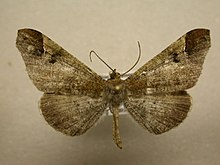Hedyloidea
| Hedylidae | |
|---|---|
 |
|
| Macrosoma bahiata | |
| Scientific classification | |
| Kingdom: | Animalia |
| Phylum: | Arthropoda |
| Class: | Insecta |
| Order: | Lepidoptera |
| Division: | Ditrysia |
| (unranked): | Rhopalocera |
| Superfamily: |
Hedyloidea Scoble, 1986 |
| Family: |
Hedylidae Guenée, 1857, nec. Bergh, 1895 |
| Genus: |
Macrosoma Hübner, 1818 |
| Type species | |
|
Macrosoma tipulata Hübner, 1818 |
|
| Genera and synonymy | |
|
Macrosoma Hübner, 1818
for Species, see List of species |
|
| Diversity | |
| 35 currently recognised species | |
Macrosoma Hübner, 1818
for Species, see List of species
Hedylidae, the "American moth-butterflies", is a family of insects in the lepidopteran order, representing the superfamily Hedyloidea. They have traditionally been viewed as an extant sister group of the butterfly superfamily Papilionoidea. In 1986, Scoble combined all species into a single genus Macrosoma, comprising 35 currently recognized and entirely Neotropical species, as a novel concept of butterflies.
Hedylidae were previously treated as a tribe of Geometridae: Oenochrominae, the "Hedylicae" Prout considered they might even merit treatment as their own family. Scoble first considered them to be a hitherto unrecognised group of butterflies and also suggested Hedylidae might possibly constitute the sister group of the "true" butterflies (Papilionoidea), rather than of (Hesperioidea + Papilionoidea). Weintraub and Miller argued against this placement (but see). In 1995, Weller and Pashley found that molecular data did indeed place Hedylidae with the butterflies and a more comprehensive study in 2005 based on 57 exemplar taxa, three genes and 99 morphological characters, recovered the genus Macrosoma as sister to the ("true butterflies" + "skippers"). However, the most recent phylogenetic analyses shows that skippers are true butterflies belonging within the clade Papilionoidea, whereas the hedylids are a sister group that may be closely related to the obtectomeran moths. This is contrary to some earlier studies that had shown both the skippers and hedylids as being nested within the Papilionoidea.
...
Wikipedia
